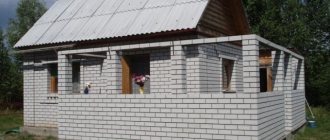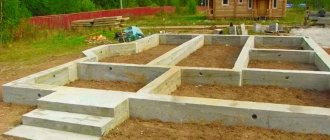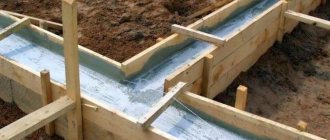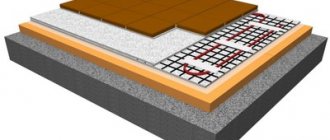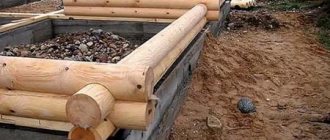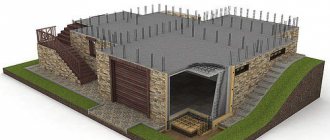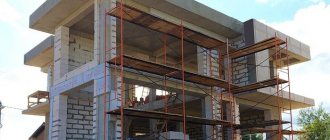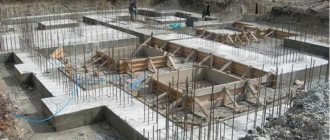Traditional strip foundations are built from reinforced concrete. A concrete solution is used, which is poured into the formwork and reinforced with metal rods.
Without reinforcement, the structure will not receive adequate strength and resistance to loads of all types. But you can do without reinforcement - if you use rubble stone.
And a correctly calculated, competently constructed rubble concrete strip foundation will not be inferior in characteristics to a monolithic reinforced concrete one.
Material characteristics
Rubble concrete is a type of concrete, the coarse filler of which is natural stones of irregular shape and fragments of bricks. Broken blocks with low strength and high porosity are not suitable for use - compared to the rest of the concrete mass, they have reduced reliability and are subject to destruction under intense loads.
The technical characteristics of rubble concrete depend on the properties of the filler. For example, a structure with broken bricks weighs slightly more than one with large crushed stone or rubble. Due to the heterogeneity of materials, it is impossible to identify certain characteristics of rubble concrete. Here are the average data:
- the volumetric weight (density) of rubble concrete is determined by the brand of binder and coarse filler used, on average it is 2300...2900 kg/m³;
- the mixture contains 40-60% large stones, which affects the weight of the structure;
- The strength of rubble concrete is determined by the brand of cement, but due to the characteristics of the material, it is not easy to calculate it. Experts use a binder of a higher grade than the expected strength of the stone; for example, to mix M200 rubble concrete, they use M400 Portland cement.
The specific gravity of rubble concrete is difficult to determine; in practice, this is not done because it is unnecessary - the properties of the fillers change, so the average value for the density and mass of materials is taken.
Rubble foundation: pros and cons
To make a decision, let’s look at the rubble foundation and take into account all the pros and cons. Remembering that the foundation is the most important part of the building, let's get started.
The advantages of buta bases include:
- Durability. Natural stone is more durable than concrete, and the service life of a rubble foundation is usually more than 150 years;
- Environmental cleanliness;
- The water resistance of a rubble concrete foundation is higher than that of a reinforced concrete foundation;
- Masonry made of large natural stone has an attractive appearance.
It is important to know about the disadvantages. The disadvantages of a rubble foundation include:
- Relatively high price of buta when purchasing it;
- Laying stone is a longer process than pouring a reinforced concrete base;
- Natural stone laying skills required.
Please note that a large bottle can weigh more than 10 kg. Working with stones weighing more than 30 kg is not recommended
Components
The composition of rubble concrete for the foundation includes several main components:
- rubble stone (40-60%);
- river sand of medium fraction;
- cement M400, M500;
- water;
- plasticizers.
Natural rubble stone can be any size with one limitation - the length of the fragments should not exceed 1/3 of the width of the foundation wall. You can use half-bricks and fragments of ceramic blocks, large crushed stone, and rock clastics. Rubble stones must first be cleaned of plaque and dirt by screening or washing with a stream of water.
High grade cement M400-M500 is suitable for obtaining a structure of optimal strength corresponding to M300-M400.
Purified river sand is included in rubble concrete as a fine filler. It is used with cement in a ratio of 3 to 1, maybe 2 to 1 to improve the strength of the structure.
Plasticizers are recommended to be added to the cement mortar for the foundation in order to improve its plasticity and laying. These can be modifier additives to increase the frost resistance of the material and water resistance.
Water is added to the solution as needed in small doses.
The consumption of ready-made cement mortar per 1 cubic meter of rubble concrete is 40-60%, depending on the amount of rubble in the volume of the structure.
The exact composition of the components is determined structurally and depends, again, on the rubble filler.
Features of such a foundation
Why is rubble concrete foundation popular in rural areas? Because the main material for its construction is natural stone of various shapes, sizes and weights. As a rule, sandstone, granite, and less often basalt, as well as river pebbles, are popular. If there is a sand or granite quarry nearby, then such raw materials will become practically free, and a concrete solution, preferably quite liquid, is used as a binder.
This results in a strong, reliable, durable and environmentally friendly foundation made of rubble concrete.
Features of a rubble concrete foundation
Unlike a conventional concrete foundation, a rubble structure is laid out in the same way as a block foundation; the stones are not mixed in the mortar. This is the difficulty: the stones must be laid, not poured into formwork, and their specific shape requires a professional approach. The installation of a rubble concrete foundation should be done by masons, this way you can get a tape of maximum strength, it will be durable and reliable.
It is advisable to include reinforcement in the tape - even for a small structure, additional insurance in the form of strengthening the base will not hurt.
Foundation advantages:
- reduced cost of construction due to the use of rubble stone and broken brick (the latter can often be obtained for free). During construction, it is possible to save up to 30% compared to the construction of a classic reinforced concrete strip;
- the durability and reliability of a properly constructed rubble concrete structure is not inferior to other types of foundations;
- a base made of rubble concrete looks impressive and does not require additional cladding, especially if natural stone was used for installation. In this way, you can set the wall from base to wall without transitions;
- the foundation is suitable for construction on any type of soil except floating;
- Even a non-professional can do the installation, but it will take a little more time than a mason;
- A special feature of a foundation made of rubble concrete is that it can easily withstand freezing and thawing and is suitable for installation in any climatic zone.
The material's resistance to low temperatures makes rubble concrete an ideal material for construction in winter. A fragile structure can be left unprotected when it reaches 50% of its design strength.
The disadvantage of the design is that despite the abundance of information about rubble concrete, choosing the ideal composition of this material is not easy even for a professional. It is important to consider the characteristics of the stones used as coarse filler.
Selection of rubble stone
Rock elements of a certain shape and size are used as rubble stone. They are formed during the fractionation process during the production of crushed stone. To select material of the required size, a special screening and crushing complex is usually used, although in some cases stones are also selected manually, which affects its final cost.
Rubble can be used in construction, architecture, and landscape design. Although this material is durable, it is worth paying attention to certain parameters when choosing it, which will extend the life of the finished structure. So, in order to build a high-quality rubble concrete foundation with your own hands, you should take stones that meet a number of criteria:
- The rubble elements used should have approximately the same size, equal to 20x25 centimeters. The use of too small specimens will significantly increase cement consumption, and too large ones will reduce the stability of the foundation.
- It is undesirable to build a foundation made of stones with noticeable cracks, as this may lead to a violation of the integrity of the structure after its commissioning.
- Do not use contaminated material, otherwise it will not adhere well to the cement mixture.
- Each stone must be durable, which can be checked by hitting it with a hammer. If the rubble crumbles under the influence of this tool, the quality of the material is very low and should not be used. Good cobblestones remain intact and produce a ringing sound.
Sizing
Determining the parameters of the tape is a priority task. What the width and height of the foundation wall will be depends on the type of soil and the thickness of the vertical wall structures.
The height of the underground part of the foundation can be of two types:
- shallow-depth does not reach the lower level of soil freezing, depends on the mass of the building - for a light structure on a solid foundation you can take 20-30 cm, for a one-story house or bathhouse - about 50 cm.
- conventional penetration below the freezing level is rarely used when working with rubble concrete.
To the accepted height we add the size of the base - at least 20 cm, optimally 30 or 40.
The width of the wall is determined by the thickness of the wall installed on the foundation. According to the standards, the lower load-bearing structure should not be narrower than the upper one; when working with rubble concrete, it is optimal to increase the lower one by 5-8 cm for the convenience of installing stones and increasing the area of load transfer to the ground.
Construction technology of strip rubble concrete foundation
The work process consists of several successive stages:
- Zero cycle. In this case, the land is cleared. The condition of the soil is also assessed. The groundwater level in the area is measured. Only after receiving this data can you proceed to the next stage.
- Preparing the construction site. The top fertile layer of soil, usually up to 50 mm thick, is removed. Using wooden pegs and twine, markings are made where the trenches will be dug.
- Land works. The raised soil from the trench can be used to level the area. If there is no such need, it should be removed immediately.
- Construction of a cushion for the foundation. To do this, a layer of crushed stone and sand is laid at the bottom of the trench. Each layer is well compacted. Next, lay the waterproofing layer overlapping. Due to this, moisture will not leave the solution.
- Afterwards, the solution is poured, with a layer thickness of up to 150 mm. This layer must be completely hardened. Thanks to this, the rubble stones laid on top will not be pressed in. Plus, the stones should not touch each other.
- Next, the formwork is installed. Given the weight of the base, the installation of reinforcing beams must be installed frequently.
- Next, you can fill the solution with a layer of up to 2500 mm. Rubble stone is laid in it. It should look exactly halfway. They should be located at intervals of about 50 mm from each other.
Figure 1.3 : Ready rubble concrete foundation with a leveled surface, completely ready for laying walls
Expert advice! In the first row it is unacceptable to lay cobblestones that have sharp ends that can damage the waterproofing layer.
- The seams should not be tied together, so the laying is carried out in a vertical direction, while maintaining a horizontal line.
- Next, another layer of mortar is poured and cobblestones are installed in the same way.
This entire process is repeated until the strip foundation reaches the required height. The topmost row should be completely covered with mortar and a flat platform will be formed for the construction of load-bearing walls of the building.
What is a rubble foundation structure?
Figure 1. Rubble foundation
Let's take a closer look at what this is: a rubble foundation. It is the construction of a reliable foundation that becomes the fundamental stage that precedes other work during the construction of buildings or other structures. Although the construction market is saturated with various materials, natural raw materials always remain in demand. This also includes rubble, which is a high-quality rock used in construction.
Sometimes people, out of ignorance, believe that laying stones in the foundation is impossible due to their irregular shape. But, even with minimal construction experience, a person is able to competently build a rubble foundation with his own hands. This is exactly what builders usually did not so long ago.
The rubble concrete base increases the external attractiveness of the structure and makes it possible to carry out work at minimal cost using basic technology. Practical experience proves that the service life of such a foundation exceeds one and a half centuries; ancient fortresses built from such natural material are still intact. The main advantage of the stone is its resistance to soil freezing and groundwater.
Advantages and disadvantages
Even before making a decision on the construction of a rubble foundation, it is advisable to consider all its qualities. Positive parameters:
- the design is durable, can withstand 3 floors of large areas;
- material - natural raw materials, completely harmless to the environment and people;
- the resulting foundation is durable;
- high wear resistance;
- the base allows you to build a structure of any size and shape;
- there is no need to perform additional reinforcement of the structure;
- the foundation is moisture resistant;
- has an aesthetic appearance;
- allows you to combine base options;
- does not freeze;
- there is no need to carry out repair actions.
Negative qualities:
- high price;
- you must have certain work skills;
- laying is manual only;
- with uneven stones, additional effort is required;
- If there is a design error in strength, it is necessary to organize additional reinforcement.
Some tricks in constructing a rubble base
To achieve an acceptable result when building a rubble foundation, you need to know how to simplify the work while simultaneously increasing the efficiency of your actions:
- the solution used to perform the filling must be stirred periodically with a vibrator until the work is completed;
- when work is suspended for more than a day for certain reasons, it is necessary to put a special coating on the surface of the laid rubble to protect the structure from premature drying (before resuming construction, clean and lightly moisten the entire structure so as not to disturb the adhesion of the previous layer to the next one);
- to continue masonry work, prick the hardened mortar with a sharp tool, remove excess parts to ensure high-quality adhesion of the cement mixture;
- if you are laying stone in a trench where the slopes are gentle, create a platform in the space remaining between the wall and the rubble;
- with steep slopes inside the trench, be sure to make scaffolding from the outside;
- For convenience, it is recommended to use an assistant;
- It is better to strengthen the trench walls with shields.
